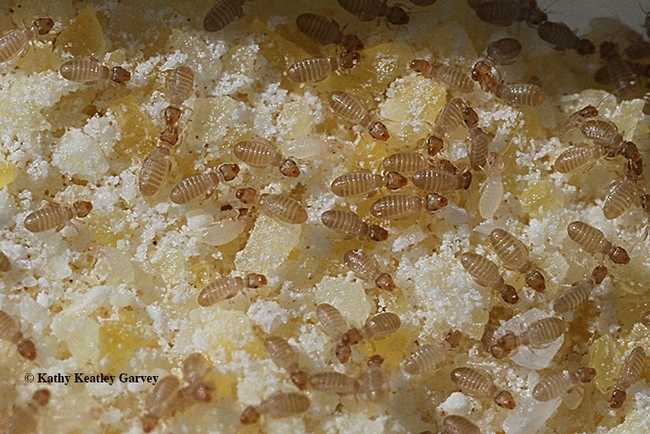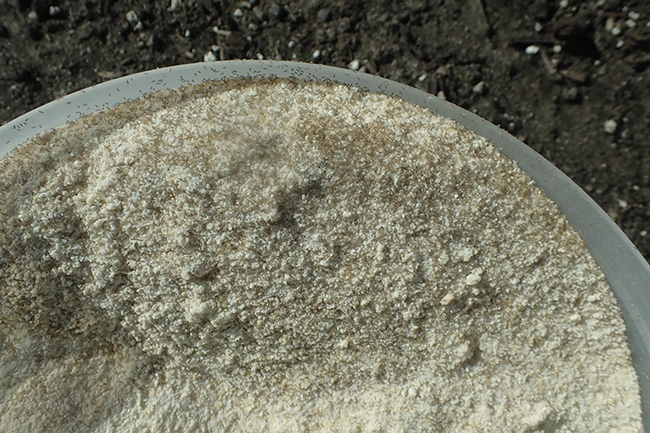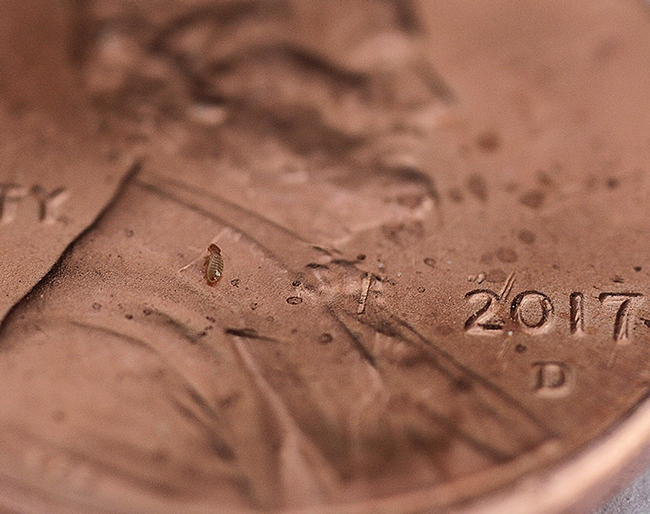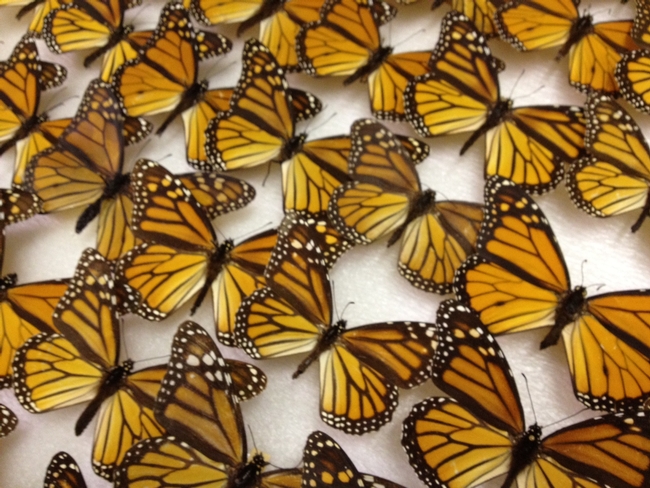Posts Tagged: entomology
What's that in your cornmeal?
You're thinking about making Grandma's Southern Cornbread.
You head for your pantry. You remember that six months ago you purchased a bag of cornmeal from a local supermarket and that you immediately emptied the contents into a glass jar with a tight-fitting lid.
You open the airtight jar and notice something strange. It's moving. Moving? Moving? Yes! It's crawling with a transparent carpet of dozens of nearly microscopic critters.
What? First, what are they? If you're like me, you grab your camera--in this case, a Canon EOS 7D with an MPE-65mm lens that can magnify an insect five times its life size--and click the shutter.
You post the photo on BugGuide.Net and request an identification.
The entomologists all agree: They're booklice, Liposcelis bostrychophila.
- Class Insecta (Insects)
- Order Psocodea (Barklice, Booklice, and Parasitic Lice)
- Suborder Troctomorpha
- Family Liposcelididae (Booklice)
- Genus Liposcelis
- Species bostrychophila (Booklouse)
These Liposcelis bostrychophila, or "psocids" (pronounced "so kids"), are common pests in stored grains. They're usually unseen because they're about a millimeter long--about the size of a speck of dust--and are transparent to light brown in color. They're also wingless, but can they ever crawl!
Fact is, their name, "lice," is misleading. These tiny insects are not lice; they are not parasitic. And they're everywhere. They feed on flour, cereals, grits, molds, fungi, papers, books, pollen, dead insects and the like. In fact, you've probably unknowingly eaten them--or parts of them--in your pancakes, your oatmeal or maybe even your chocolate birthday cake.
Entomologist Jeff Smith, who curates the butterfly-moth collection at the Bohart Museum of Entomology at UC Davis, took one look at the photo and commented: "They're pretty thick in there!"
"Booklice can be scavengers and often feed on the bits of mold or fungi that grow on damp materials," Smith explained. "Very old, neglected food stuffs are also subject to them, and the key to prevention is to use food materials reasonably quickly and not store them for years, store them in a nice dry location and in airtight containers."
"They very well could have been in the food already when you bought it, but they're so common that you probably have some roaming around in the house all the time, just looking for something good to eat. They'll feed on dead bugs in window sills, stale pet foods, etc."
If you're worried about what's in your cornmeal, flour, oats, biscuit mix, cake mix and other stored foods, you can pop the contents in your oven at about 120° for a half hour, and then transfer them to an airtight container, Smith says. "Your food should be okay--albeit perhaps containing a few dead booklice. We had them in an old bag (paper) of rice one time, and in several packages of cornmeal mix that were forgotten in the back of our cupboard."
A UC Davis colleague said he's seen them crawling in his flour, but his wife made pancakes from them anyway. No issues. No problem. "Just protein!" he chortled.
And from another colleague: "I once had an entire case of instant grits. The grits were completely factory-sealed in unopened plastic bags. I opened the bags and the grits were poured into hot water, but they would not sink and mix with the water. Instead the grit floated on the top of the water. I opened a second bag and looked at the grits under my stereo microscope. Each and every grain of grit had two or three little six-legged creatures standing on each grit. These creatures were 100 percent transparent, the only color was in their bodies which was the same color as the grits they were eating. I opened every 100 percent factory-sealed bag, and every bag was contaminated in this matter."
"There is nothing new about insect contamination of grain products," she added. "Another personal experience was a biscuit mix. For no particular reason, I sifted the biscuit mix while making the batch of biscuits. After sifting several cups of biscuit mix, in the sifter screen there were 4 worm-like creatures about the diameter of a standard pencil and about an inch long. These worms were 100 percent transparent, each filled with the white biscuit mix. "Consider we all eat insects, spiders, and urine and feces of all sorts of animals."
We live in world where we all eat bugs, whether we know it or not. Sometimes we may not want to know!
Statistics indicate that the average American unknowingly eats one to two pounds of insects a year. But the U.S. Food and Drug Administration "has very specific tolerances for the amount of residue in food stuffs," said Lynn Kimsey, director of the Bohart Museum of Entomology and professor of entomology at UC Davis.
Want to know what the action level is? Check out this FDA document.
And the next time, you're yearning to make Grandma's Southern Cornbread, you might want to check for bugs first. Or maybe not. You might not want to know!

This image, taken with a Canon MPE-65mm lens, shows booklice, nearly microcopic insects, in cornmeal. The insects are about 1 millimeter long, or about the size of a speck of dust. (Photo by Kathy Keatley Garvey)

With the naked eye, booklice or Liposcelis bostrychophila, are nearly invisible. (Photo by Kathy Keatley Garvey)

Find the booklouse! It's on this penny, magnified with the powerful Canon MPE-65mm lens. (Photo by Kathy Keatley Garvey)

Odds are that the flour, cornmeal and other stored products you buy in a grocery store contain insects parts or nearly microscopic insects. It's estimated that the average American unknowingly eats one to two pounds of insects or insect parts a year. (Photo by Kathy Keatley Garvey)
Potato chips: going, going … not gone!
It’s easy to finish half a bag of chips, or more, while being spread out on a couch, watching TV, the remote near and handy. So robotic can such chip consumption be that it’s easy, too, not to glance at the chip parade traveling resolutely from bag to mouth. But glance we must, for had it not been for the work of a research team, those healthy potato chips for most of us today would be out of reach and pricey, crunched into a crisp footnote in potato history.
The research team, which rescued the potato chip industry from major losses, is the “Zebra Chip Research Team.” It has just won the Integrated Pest Management Team Award from the Entomological Foundation, a national organization that aims to educate young people about science through insects. The foundation recognized the team for its research and extension efforts that have had a dramatic effect on the potato industry.
John Trumble, a distinguished professor in the Department of Entomology at the University of California, Riverside, is a member of the Zebra Chip Research Team. He explained that by the time the team formed in 2008, a new pathogen had devastated the potato industry by spreading zebra chip disease, causing losses in the millions of dollars annually (see Q&A below).
“Indeed, many growers were on the verge of leaving the industry entirely,” he said. “When pesticide use in the fields increased dramatically, with unsatisfactory results, more economic losses followed.”
The Zebra Chip Research Team developed new techniques to identify the pathogen, allowing researchers to document local, regional, and national movements of the potato psyllid (Bactericera cockerelli) spreading zebra chip disease. The researchers determined both within-plant and within-field movements of the psyllid and the zebra chip pathogen, and developed special sampling programs that enabled potato growers to choose the level of risk they were willing to accept.
The sampling programs accurately determined the efficacy of pesticides and the benefit of available biological control agents. They also documented a variety of alternatives to unsustainable pesticide use. Through websites, effective outreach practices, and grower and scientific meetings, the Zebra Chip Research Team promoted a sustainable integrated program that today allows the industry to continue to produce potatoes while making a profit and minimizing potential negative effects for the environment.
Besides Trumble, the following researchers are members of the Zebra Chip Research Team: Charlie Rush, an epidemiologist at Texas A&M University; Neil Gudmestad, a plant pathologist at North Dakota State University; Gerhard Bester of Frito Lay; Casey Butler of Syngenta Crop Protection; Joe Munyaneza, an entomologist, and Jim Crosslin, a plant pathologist, at USDA-Agricultural Research Service, Yakima, Wash.; Jon Goolsby, an entomologist at USDA-Agricultural Research Service, Edinburgh, Texas.; Don Henne, a horticultural scientist at Texas Agrilife Research, Weslaco; and Fekede Workneh, a plant pathologist at Texas Agrilife Research, Bushland.
Congratulations to them all for their work on zebra chip disease and the recognition they received from the Entomological Foundation!
Q&A with Trumble:
Where in the country is the disease affecting potatoes?
Arizona, California, Colorado, Kansas, Nebraska, Nevada, Oregon, New Mexico, Texas, and Washington State. Problems have now been reported throughout California, including Riverside County, Kern County and Ventura County. We find it in our experimental plantings in Orange County.
What kind of economic loss has zebra chip disease caused?
In the 2004-06 growing seasons, Texas growers estimated losses at over $25 million. Many growers during and since then have abandoned fields, with Texas reporting about a 20% reduction in planting. Guatemala, Honduras and New Zealand have reported over 80% of plants infested and losses of nearly all marketable size tubers. Dollar losses in California have not been estimated, but growers throughout the USA dramatically increased pesticide applications, which greatly increased production costs. Much of the Team's efforts were designed to determine how to economically control the pest. We did this by minimizing or eliminating use of the class one (highly toxic) pesticides, developing control strategies with low environmental impact and high economic return for the investment, and increasing use of beneficial insects.
Could you please pass me the bug kabobs?
Possibly, people could be divided into the following two groups: those who knowingly eat insects, and those who think they have never eaten them. Since I am still assailed by the odd nightmare in which I am bringing to my lips a well-cooked bug that suddenly springs to life, I decided to tackle my bug-food phobia by visiting entomologist Douglas Yanega of UC Riverside last week.
Yanega has eaten insects, even relished them. With no difficulty whatsoever he has ingested honey bees, termites, mealworms, crickets, grasshoppers, ants, June beetles, silkworms and even scorpions.
Eating insects is not unusual in Thailand, Yanega explained. Insects, a good source of highly digestible protein, are part of the diet in Korea, China and Mexico as well.
“You get more bang for the buck when you eat insects, where protein is concerned,” Yanega said. “True, the outer hardened shell is often not digestible, but the softer, internal tissues are. Of course, you want to avoid toxic insects. There are some that could kill you if you ate them.”
How does one know if an insect is toxic? In general, herbivorous insects tend to be more edible. Moreover, insects have evolved to alert other critters — and us! — that they are not suitable for consumption. Bright colors like red, orange or yellow juxtaposed with black on insect bodies are a sure warning from insects that you’d better stay away.
Because few people experiment with eating insects, identifying those that are both edible and delicious can be a big challenge.
“You have, in the middle of the bell curve of insects, a whole lot that are edible but taste awful,” Yanega said. “And there are those at one end of the curve that are just toxic. But at the other end of this curve lie the prized ones: these are edible and tasty.”
In the United States, most people are culturally still averse to eating insects. If you travel to Mexico, however, you might eat stinkbugs, sometimes used to flavor food. Farther off, in Japan, you could enjoy wasp grubs and silkworm larvae. In the mainland parts of Southeast Asia, you can savor giant water bugs and mole crickets.
According to Yanega, one way to get introduced to an entomological diet is to first dry out insects, and then grind them up to a powder.
“You can use this powder as a supplement,” he said. “It’s the easiest way to go about eating insects as food. You can mix the powder into, say, wheat flour to get 'insect-enriched flour.'
If you’re cringing, rest assured that most of us already eat insects unknowingly. Much of food coloring uses insects. The waxy coloring that coats candies is oftentimes insect-based. And a lot of fresh produce has a built-in level of “insect contamination.”
“As long as you are not allergic to an edible insect, you’re safe eating it,” Yanega said. “If you can get past your phobia or stigma of putting bugs in your mouth, you should have no difficulty in adding insects to your diet.”
Which is what most of us would have to do if we found ourselves stranded on an island and famished.
“Should that happen, never mind the brightly colored bugs,” Yanega said. “Instead, go after the ones that are cryptically colored, the ones that look as though they are hiding from something. They would be a much better bet.”







